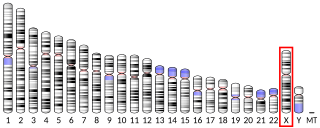The L1 family is a family of cell adhesion molecules that includes four different L1-like proteins. They are members of the immunoglobulin superfamily. The members of the L1-family in humans are called L1 or L1cam, CHL1, Neurofascin and NRCAM. L1 family members are found on neurons, especially on their axons. Sometimes they are found on glia, such as Schwann cells, radial glia and Bergmann glia cells and, as such, are important for neural cell migration during development. L1 family members are expressed throughout the vertebrate and invertebrate kingdoms.

L1, also known as L1CAM, is a transmembrane protein member of the L1 protein family, encoded by the L1CAM gene. This protein, of 200-220 kDa, is a neuronal cell adhesion molecule with a strong implication in cell migration, adhesion, neurite outgrowth, myelination and neuronal differentiation. It also plays a key role in treatment-resistant cancers due to its function. It was first identified in 1984 by M. Schachner who found the protein in post-mitotic mice neurons.

Neural cell adhesion molecule L1-like protein also known as close homolog of L1 (CHL1) is a protein that in humans is encoded by the CHL1 gene.

Cell adhesion molecule 1 is a protein that, in humans, is encoded by the CADM1 gene.

Contactin 1, also known as CNTN1, is a protein which in humans is encoded by the CNTN1 gene.

Neurexin-1-alpha is a protein that in humans is encoded by the NRXN1 gene.

CD166 antigen is a 100-105 kD typeI transmembrane glycoprotein that is a member of the immunoglobulin superfamily of proteins. In humans it is encoded by the ALCAM gene. It is also called CD166, MEMD, SC-1/DM-GRASP/BEN in the chicken, and KG-CAM in the rat.

Contactin-2 is a protein that in humans is encoded by the CNTN2 gene.

Neurofascin is a protein that in humans is encoded by the NFASC gene.

Basal cell adhesion molecule, also known as Lutheran antigen, is a plasma membrane glycoprotein that in humans is encoded by the BCAM gene. BCAM has also recently been designated CD239.

Junctional adhesion molecule B is a protein that in humans is encoded by the JAM2 gene. JAM2 has also been designated as CD322.

Disks large-associated protein 1 (DAP-1), also known as guanylate kinase-associated protein (GKAP), is a protein that in humans is encoded by the DLGAP1 gene. DAP-1 is known to be highly enriched in synaptosomal preparations of the brain, and present in the post-synaptic density.

Sodium channel subunit beta-1 is a protein that in humans is encoded by the SCN1B gene.

Opioid-binding protein/cell adhesion molecule is a protein that in humans is encoded by the OPCML gene.

Intercellular adhesion molecule 5 is a protein that in humans is encoded by the ICAM5 gene.

Contactin-4 is a protein that in humans is encoded by the CNTN4 gene.

Cell adhesion molecule 3 is a protein that in humans is encoded by the CADM3 gene.

Neurotrimin is a protein that in humans is encoded by the NTM gene.

Contactin-3 is a protein that in humans is encoded by the CNTN3 gene.

Gene HEPACAM*, named based on its original site of identification - hepatocytes and the nature of its protein product - a cell adhesion molecule (CAM), was first discovered and characterised in human liver and reported by Shali Shen in 2005. The gene encodes a protein of 416 amino acids, designated as hepaCAM**, which is a new member of the immunoglobulin superfamily of cell adhesion molecules. The main biological functions of hepaCAM include a) modulating cell-matrix adhesion and migration, and b) inhibiting cancer cell growth.




















